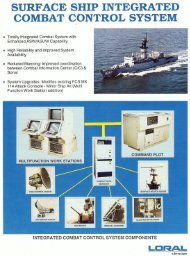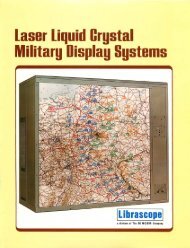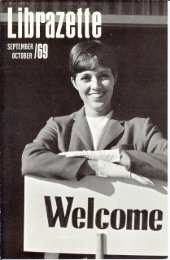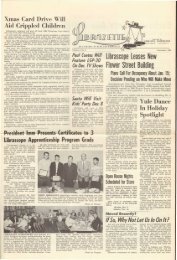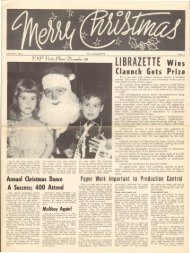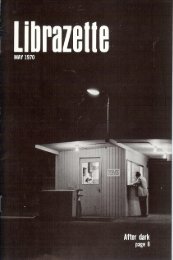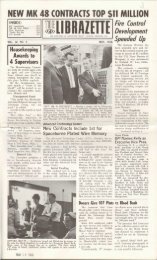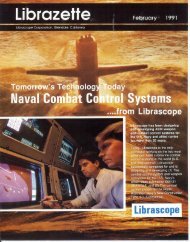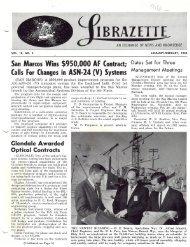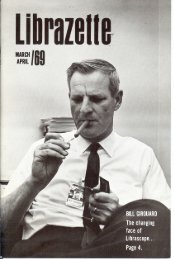Technical Review - Fall 1959. - Librascope Memories
Technical Review - Fall 1959. - Librascope Memories
Technical Review - Fall 1959. - Librascope Memories
Create successful ePaper yourself
Turn your PDF publications into a flip-book with our unique Google optimized e-Paper software.
vital functions. With the computer doing<br />
time consuming routine work, the<br />
Navigator is freed to make decisions<br />
without distraction. He has time to keep<br />
up with navigation problems as speeds<br />
increase and tolerances decrease. And<br />
he can utilize a number of more sophisticated<br />
navigation techniques.<br />
At the crew briefing session, the Navigator<br />
receives the information from<br />
which he prepares his navigation flight<br />
plan. This information includes weather<br />
data, reporting points, ADIZ corridors,<br />
and alternate destination, which changes<br />
from flight to flight. The Navigator<br />
notes data needed by the computer.<br />
During the preflight check-out the<br />
Navigator feeds the data from the briefing<br />
into the computer. Already locked<br />
in the computer's memory are the equations<br />
it must use in making the navigation<br />
computations. It also stores tables<br />
of magnetic variation and deviation, for<br />
the entire Earth, as functions of aircraft<br />
position and heading, LORAN station coordinates,<br />
TACAN station positions, and<br />
the hour angle and declination of 57<br />
stars to be used in celestial navigation.<br />
As the Navigator feeds the new information<br />
into the computer, the computer<br />
itself is already sampling the various<br />
navigation aids and entering the data<br />
into the temporary storage portion of<br />
its memory. At the same time, it has begun<br />
the important self-checking of its<br />
myriad of logic circuits. Should any<br />
portion of the computer fail to respond<br />
correctly to the self-checking, the computer<br />
flashes a warning to alert the Navigator.<br />
The computer continues to check<br />
itself automatically throughout the flight.<br />
Passing over the marker beacon after<br />
take-off, the Navigator sets the computer<br />
to give him dead reckoning positions.<br />
In this mode of operation the<br />
computer samples true airspeed continuously<br />
and uses the data, together with<br />
compass readings and wind information,<br />
to compute ground speed and true course.<br />
The computer figures true ground<br />
speed and drift angle due to cross wind<br />
by using data from the Doppler radar.<br />
The Doppler radar transmits signals<br />
along four beams to the ground. The<br />
frequency of the signals reflected back<br />
to the radar vary in accordance to how<br />
rapidly the aircraft passes over the terrain.<br />
Drifting caused by cross winds<br />
causes frequency changes in the signals.<br />
The computer uses these changes to figure<br />
out the force of the cross wind and<br />
the drift angle.<br />
The drift angle and the true heading<br />
are combined to furnish the plane's true<br />
course. The ground speed is calculated<br />
and North and East velocity components<br />
are determined. These velocity components<br />
are integrated with respect to time<br />
to give the aircraft's position in latitude<br />
and longitude.<br />
The wind speed and direction determined<br />
by the computer are stored, and<br />
in case the Doppler signal fails, they<br />
are used to calculate the ground speed<br />
and course.<br />
The Navigator can examine the wind<br />
data at any time by querying the computer.<br />
Wind information is used by the<br />
Navigator for locating jet streams, comparing<br />
forecast with actual wind conditions,<br />
and for making wind reports.<br />
As a constant check on the dead<br />
reckoning calculations, the computer<br />
uses several radio navigation aids. Out<br />
over the middle of the Atlantic, LORAN<br />
is highly accurate and convenient to<br />
use. The positions of the LORAN stations<br />
to be used during the trans-Atlantic<br />
flight have been stored in the computer's<br />
memory and the Navigator can<br />
add the coordinates of additional stations<br />
at any time.<br />
LORAN fixes the aircraft's position by<br />
determining the time delay between the<br />
receipt of radio signals from two ground<br />
based stations. A hyperbola represents




